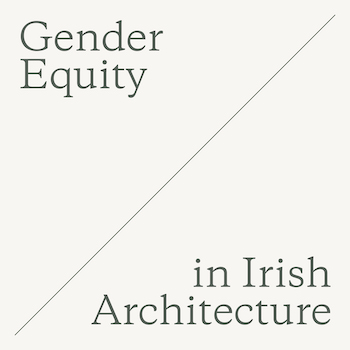Where are Ireland's women architects?
Wednesday, 19 July, 2023
Dr Dervla MacManus is a postdoctoral research fellow at the School of Architecture, Planning and Environmental Policy at University College Dublin. Her project, “Gender equality in Irish architecture: where are Ireland's women architects?” is funded by the (opens in a new window)Irish Research Council with enterprise partner the (opens in a new window)Royal Institute of Architects Ireland.

Every year in Ireland an equal number of men and women begin studying architecture at Third Level. But eventually, in the workplace, that gender balance becomes disappointingly skewed.
“We've known for some time that we have a roughly 50:50 male to female ratio in university in architecture. But when we get to registration - and if you want to call yourself an architect, you have to be registered - that ratio is 70:30,” says Dr Dervla MacManus. “This year our registered architects are 30% women and 70% male, a statistic replicated in other jurisdictions around the world.”
There is no data to explain this dramatic drop-off in female participation in the field in Ireland, a knowledge deficit MacManus’s project will address.
“What we don't know is whether women are not joining the register or whether they're joining the register and then leaving after a number of years. We don't know if they are working in the architecture discipline, which is broader than being an architect as a profession, but aren't actually on the register.”
MacManus herself fits into this latter category. Though she works at “the coalface” of architecture through her work researching and teaching at UCD, she is no longer a practising architect on the register.
“ We don’t know how many other women are also working in related fields. Nonetheless, the discrepancy persists. Why is it that registered architects are 70% male and 30% female? What is it that is going on? This project is going to try and get to grips with that. ”
UK’s Architects Registration Board published figures showing that though the overall number of women in the sector was 29%, there is a 50:50 gender ratio for those aged under 30.
“So that sort of points you towards the direction of maybe when women start to have children - or take on more caring responsibilities - that's when the pinch happens. But that's guesswork. We don't actually know.”
MacManus describes becoming qualified as an architect as “a long road”, involving the completion of both an undergraduate and a Master’s degree.
“Then you have to do what we call your Part Three, which is where you have to do postgraduate learning in a working environment. Then you do your Part Three exams and then you can finally become a registered architect.”
Despite this considerable workload prior to graduation, “architects are not terribly well paid” and work “very long hours”. MacManus says the profession is taught to be seen as something of a “vocation” where the work is “never finished - there’s always something more you could do”. This leads to overworking “to the point where you're no longer being paid for this and we are now into free hours”.
This kind of culture may not always be harmonious with family and other commitments, especially when, as MacManus points out, “an ESRI study says 75% of caring duties are still carried out by women”. Reducing the long-hours culture in architecture, she adds, “would benefit everyone”.
MacManus is designing two surveys to help gather the data she needs to answer her research question. The first is aimed at anyone in architecture.
“You don't have to be a woman to take the survey, but it is primarily about finding out why women leave. It will look at the reasons around that.”
The second survey aims to decipher a more granular gender breakdown, looking at career progression, salaries, attitudes and experiences.
“How many women directors do we have in architecture? What is the gender pay gap in architecture? How long does it take for a man to become a director or partner? How long is the same trajectory for women? What are the attitudes towards gender equity? Do women perceive themselves that they feel equal in the workplace? Or do they not?”
The surveys will help to finally put statistics on the gender breakdown from the most junior to senior levels in Irish architecture firms.
“We know anecdotally that the number of women in senior roles is very low but we don’t actually have figures on it.”
Her research will also explore whether a potential lack of workplace flexibility could be sidelining women.
“ Like any other industry, if you are losing women or if women aren't in the room, then they're not there to be part of the decision-making process. And if we're losing women out of architecture as they get into child-rearing - and if they're not coming back into it - then we're not seeing women in senior roles as architects. ”
The data gathered after the surveys - which will be carried out next spring - will help inform guidelines for improving gender balance in Irish architecture. The RIAI, the regulatory and support body for architects in Ireland, is the project’s enterprise partner.
“They have backed the research from the beginning,” says MacManus. “They are really interested in having data that they can then make decisions and recommendations on. Hopefully there will be lessons and recommendations right across the scales from the individual to the practice to the construction industry to the RIAI. There is a huge wealth of Irish female talent in architecture,” she adds, “and we need the opportunity to show it”.
Listen to the (opens in a new window)podcast